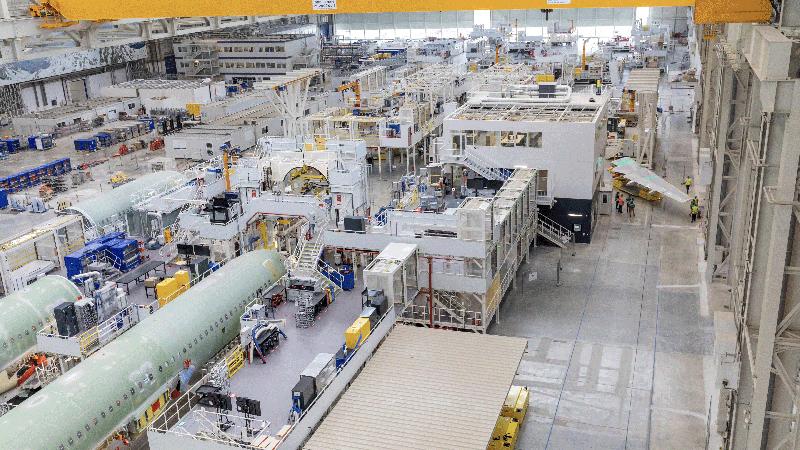Airbus Top Worry Shifts From Suppliers To Trade
Details
More Products & Services
Products & Services
Home - Aviation Group Marketing
Aviation Week Network
120 data points on over 156,000 commercial and business aviation aircraft, including military transports. Discover the most trustworthy resource for the complete aircraft history, plus ad hoc reports, month-over-month trend analysis and details on expected deliveries through 2050.
Aerospace | Aviation Week Network
Aviation Week Network
https://aviationweek.com/themes/custom/particle/dist/app-drupal/assets/awn-logo.svg
People

Andrea Rossi Prudente
Aviation Week Network

Anthony Lim
Aviation Week Network
Sales director

Becca Balmes
Aviation Week Network

Belinda Tan
Aviation Week Network

Brian Everstine
Aviation Week Network
Editor

Eddie Krankowski
Aviation Week Network
Assistant Manager, Tradeshows

erving dockery
Aviation Week Network

Lisa Tan
Aviation Week Network
Senior Marketing Manager

Mark Thomas
Aviation Week Network
Description
Airbus is glimpsing the end of narrowbody and widebody production bottlenecks, elevating questions about the global trade environment as the biggest cloud over the company's prospects.
Although the company's aircraft shipments are trailing what is needed to meet the 820-unit delivery guidance for the year, Airbus Commercial CEO Christian Scherer said the target remains attainable. “The overall disturbance of supply has abated, largely,” Scherer told reporters June 11. “It's not gone, but it is improving significantly.”
Engine deliveries, in particular from CFM International, remain a problem for A320 output but are starting to trend in the right direction. “We believe between now and the end of the year, we will get the missing engines,” Scherer said, even if CFM is still slightly behind the Leap-1A catch-up plan. Airbus has about 40 single-aisle aircraft assembled and awaiting engines before going to customers.Airbus is building 60+ single-aisle monthlyToilet supply slows widebody production
“Were it not for those engineless aircraft, our delivery performance . . . would be slightly above plan right now,” he said. A sign of that progress is that narrowbody output is climbing beyond 60 aircraft per month as Airbus strives to ramp up to 75 per month in 2027.
On A350 widebodies, the main supply issue is toilets, Scherer said. Safran, suffering from its own supply chain bottleneck, has been late with component deliveries from its plant in Mexico.
Julien Puyou, head of Airbus widebody programs, said that Safran should start to deliver toilets on time in the coming weeks and be fully caught up by year-end. “We have our supply chain teams fully engaged on-site with them to help them, support them,” Puyou said. “And of course, we are putting some pressure on them, too, so that they improve the recovery.”
While production issues are trending in the right direction, trade worries remain. Scherer called the situation “the overriding concern,” even while expressing hope that talks between the U.S. and others will succeed and prevent heavy tariffs.
Still, Airbus moderated its 20-year industrywide aircraft delivery outlook in its latest forecast, given the trade uncertainties. The aircraft industry is expected to take delivery of more than 43,420 new passenger and freighter aircraft, the OEM says. Total forecast deliveries are up 2.3% from the year-prior outlook, but that increase lags the 3.9% year-over-year increase in 2024's projection. The revision partly reflects a cut in the airframer's assumed GDP growth projection for the period to 2.5% from 2.6%.
Airbus projects delivery of 34,250 single-aisle aircraft seating more than 100 passengers over those 20 years, up from 33,510 in 2024-43. It also forecasts passenger widebody deliveries of 8,200 units, compared with the 7,980 projected last year.
Some markets are particularly affected by the trade situation, said Antonio Da Costa, head of market analysis and forecast for commercial aircraft at Airbus. But he asserted that airline demand remains resilient and will drive the need for growing fleets.
“We have not, at this moment, seen an inflection, with the possible exception of maybe the more domestic U.S. market,” Scherer added. “But we have not seen an inflection, fundamentally, in demand from our customers.”
Airbus included current tariff levels in its assumptions but not some of the highest rates the Trump administration has floated. The growth outlook “is all subject to assuming that tariffs will not become a kind of a ‘Liberation Day' level of punitive levels of tariffs that will have, let's say, a very significant COVID-like impact on trade,” Da Costa said.
One reason aircraft delivery rates are largely holding up is that the tariff effects likely will be felt more in the mature markets that are not the principal driver of aircraft delivery growth, he asserted. Lower fuel prices also are damping the effect of weaker GDP projections, Airbus suggests.
Aircraft deliveries to countries in the Asia-Pacific region are projected to drive much of the forecast demand, with China accounting for 9,570 deliveries and the other countries in the region for 10,050. By contrast, the North American market is expected to see 6,810 aircraft delivered, with Europe and some former Soviet states accounting for 8,070.
In addition, Airbus cut its global trade growth forecast through 2044 to 2.6% from 3.1%. The airframer nonetheless expects to deliver 970 new freighters compared with 940 in last year's forecast. Da Costa said high-value goods that typically use air freight, such as microchips, should continue to see healthy demand.
Airbus notes that more than 14,000 aircraft in the single-aisle delivery forecast are in manufacturers' backlogs, with a little more than 20,050 orders for airframers to win.
Although the airline industry has become more muted about growth projections in recent months, Bernstein analysts note that aircraft-makers are not keeping up with replacement needs. “Even with this lower outlook for traffic growth, deliveries from Airbus and Boeing will still significantly lag demand because production levels have been far below planned rates, and both companies are still struggling to bring delivery rates higher,” Bernstein said June 9.
Airbus expects 56% of deliveries over the period to support growth; the rest would replace existing hardware.
Although the company's aircraft shipments are trailing what is needed to meet the 820-unit delivery guidance for the year, Airbus Commercial CEO Christian Scherer said the target remains attainable. “The overall disturbance of supply has abated, largely,” Scherer told reporters June 11. “It's not gone, but it is improving significantly.”
Engine deliveries, in particular from CFM International, remain a problem for A320 output but are starting to trend in the right direction. “We believe between now and the end of the year, we will get the missing engines,” Scherer said, even if CFM is still slightly behind the Leap-1A catch-up plan. Airbus has about 40 single-aisle aircraft assembled and awaiting engines before going to customers.Airbus is building 60+ single-aisle monthlyToilet supply slows widebody production
“Were it not for those engineless aircraft, our delivery performance . . . would be slightly above plan right now,” he said. A sign of that progress is that narrowbody output is climbing beyond 60 aircraft per month as Airbus strives to ramp up to 75 per month in 2027.
On A350 widebodies, the main supply issue is toilets, Scherer said. Safran, suffering from its own supply chain bottleneck, has been late with component deliveries from its plant in Mexico.
Julien Puyou, head of Airbus widebody programs, said that Safran should start to deliver toilets on time in the coming weeks and be fully caught up by year-end. “We have our supply chain teams fully engaged on-site with them to help them, support them,” Puyou said. “And of course, we are putting some pressure on them, too, so that they improve the recovery.”
While production issues are trending in the right direction, trade worries remain. Scherer called the situation “the overriding concern,” even while expressing hope that talks between the U.S. and others will succeed and prevent heavy tariffs.
Still, Airbus moderated its 20-year industrywide aircraft delivery outlook in its latest forecast, given the trade uncertainties. The aircraft industry is expected to take delivery of more than 43,420 new passenger and freighter aircraft, the OEM says. Total forecast deliveries are up 2.3% from the year-prior outlook, but that increase lags the 3.9% year-over-year increase in 2024's projection. The revision partly reflects a cut in the airframer's assumed GDP growth projection for the period to 2.5% from 2.6%.
Airbus projects delivery of 34,250 single-aisle aircraft seating more than 100 passengers over those 20 years, up from 33,510 in 2024-43. It also forecasts passenger widebody deliveries of 8,200 units, compared with the 7,980 projected last year.
Some markets are particularly affected by the trade situation, said Antonio Da Costa, head of market analysis and forecast for commercial aircraft at Airbus. But he asserted that airline demand remains resilient and will drive the need for growing fleets.
“We have not, at this moment, seen an inflection, with the possible exception of maybe the more domestic U.S. market,” Scherer added. “But we have not seen an inflection, fundamentally, in demand from our customers.”
Airbus included current tariff levels in its assumptions but not some of the highest rates the Trump administration has floated. The growth outlook “is all subject to assuming that tariffs will not become a kind of a ‘Liberation Day' level of punitive levels of tariffs that will have, let's say, a very significant COVID-like impact on trade,” Da Costa said.
One reason aircraft delivery rates are largely holding up is that the tariff effects likely will be felt more in the mature markets that are not the principal driver of aircraft delivery growth, he asserted. Lower fuel prices also are damping the effect of weaker GDP projections, Airbus suggests.
Aircraft deliveries to countries in the Asia-Pacific region are projected to drive much of the forecast demand, with China accounting for 9,570 deliveries and the other countries in the region for 10,050. By contrast, the North American market is expected to see 6,810 aircraft delivered, with Europe and some former Soviet states accounting for 8,070.
In addition, Airbus cut its global trade growth forecast through 2044 to 2.6% from 3.1%. The airframer nonetheless expects to deliver 970 new freighters compared with 940 in last year's forecast. Da Costa said high-value goods that typically use air freight, such as microchips, should continue to see healthy demand.
Airbus notes that more than 14,000 aircraft in the single-aisle delivery forecast are in manufacturers' backlogs, with a little more than 20,050 orders for airframers to win.
Although the airline industry has become more muted about growth projections in recent months, Bernstein analysts note that aircraft-makers are not keeping up with replacement needs. “Even with this lower outlook for traffic growth, deliveries from Airbus and Boeing will still significantly lag demand because production levels have been far below planned rates, and both companies are still struggling to bring delivery rates higher,” Bernstein said June 9.
Airbus expects 56% of deliveries over the period to support growth; the rest would replace existing hardware.

Share
Recent Chats
Share via email
Future: handle WhatsApp here
Future: handle LinkedIn here
Future: handle Twitter here
SUBMENU HERE
Share via Chat
Copy Link

